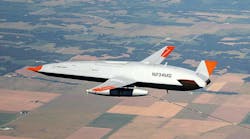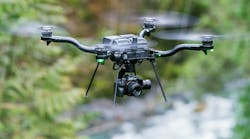By John Rhea
ARLINGTON, Va. — The terrorist attacks of Sept. 11 will nearly double the compound annual growth rate (CAGR) of the U.S. Department of Defense (DOD) budget over the next ten years, according to predictions from an influential defense industry trade group.
The DOD's budget growth will increase from a previously predicted 0.8 percent to 1.4 percent, but the NASA budget will shrink over the same period, according to projections prepared by the Government Electronics and Information Technology Association (GEIA) that were presented at the organization's 37th Annual DOD and NASA Ten-Year Forecast conference Oct. 22-25 in Alexandria, Va.
The electronics content of DOD procurement, meanwhile, is also expected to rise over the decade from $26 billion in the current fiscal year to $35 billion in 2012. This growth rate, 3.1 percent, is double the rate for the top-line DOD budget numbers, says M. Thomas Davis, a senior analyst at the Northrop Grumman Corp. office in Arlington, Va., and head of the GEIA forecast team. The GEIA study expresses all figures in constant 2002 dollars.
For DOD that means a growth from $347 billion this year to $398 billion in 2012. Prior to the Sept. 11 tragedy, Davis said, GEIA had been looking for growth from $323 billion to $350 billion.
Among the high-growth items within the top-line numbers of particular interest to the electronics industry, GEIA projected procurement to rise from $67 billion to $88 billion over the 10-year period, research, development, test and evaluation (RDT&E) from $49 billion to $56 billion, and operations and maintenance from $135 billion to $156 billion.
At NASA it is a different story, says Mary Snitch, director of civil space programs at the Lockheed Martin Corp. Arlington, Va., office and head of GEIA's study of the space agency budget.
NASA had not been particularly high on the new Bush Administration's priority list before the Sept. 11 events and, in her words, is a $20 billion agency that has had to live within a $14 billion annual budget because of excessive operating costs of the Space Shuttle and International Space Station.
Prior to the terrorist attacks, Snitch told the gathering, GEIA had projected CAGRs for NASA in the 2.2-to-2.5 percent range, but now the organization is expecting a negative CAGR of minus 1.9 percent over the 10-year period.
NASA will be able to piggyback on some DOD anti-terrorist activities, such as Earth observations, aviation safety, unmanned aerial vehicles, threat modeling, and sensor technology, she said, but this will still not reverse an inevitable decline. She did not immediately have a figure for the electronics content of the NASA budget, but this is typically among the highest of all federal agencies.
For more information contact the GEIA by phone at 703-907-7566, by fax at 703-907-7968, by post at 2500 Wilson Blvd., Arlington, Va. 22201-3834, or on the World Wide Web http://www.geia.org.


